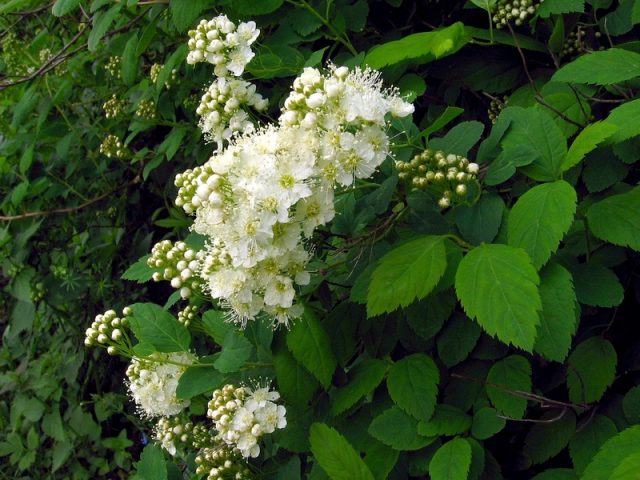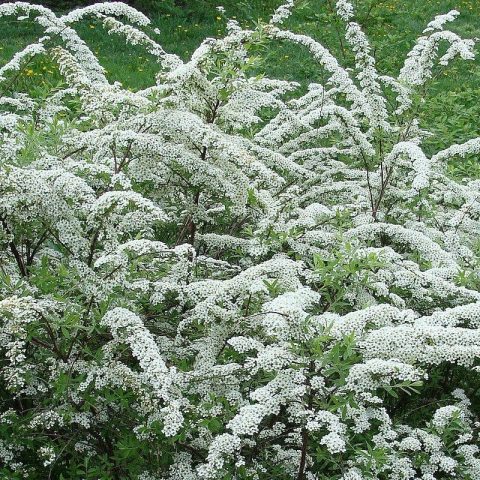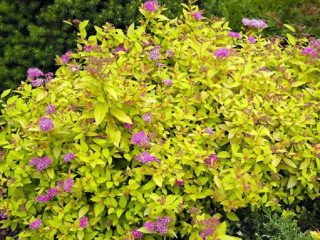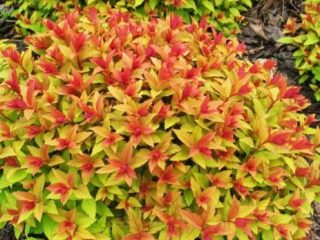Content
Spiraea in landscape design is a simple and inexpensive way to decorate any garden plot. There are more than 90 species of this plant. Shrubs can be used to form a hedge that will delight the eye with its lush blooms in spring and summer. Depending on the plant variety, its height can vary from 30 cm to 2 m.
The use of spirea in landscape design
Spiraea for hedges is used to delimit territory without the effect of isolation, edging a recreation area or flower garden. To do this, form borders and frames from low-growing shrubs. Japanese spirea is most often used in landscape design.
If borders are distinguished by severity, then in mixborders the bush gives splendor and volume, places accents, and brings picturesqueness. To decorate in this way, use Japanese, gray, Nippon or white-flowered spirea. These varieties go well with other perennial shrubs due to their lush crown and expressive lines.They contrast especially well with decorative deciduous and evergreen plants.
Miniature and dwarf varieties are used to decorate alpine slides. They bloom beautifully and have a luxurious crown. Spiraea fits perfectly into landscapes where large stones and boulders are present. Shrubs are visually combined with carpet and perennial plants, giving the composition harmony and airiness.
For rockeries and rock gardens, low-growing spireas with dense crowns are chosen.
Plants are used in the design of alleys and groups of bushes to create colorful undergrowth. Lilac, mock orange or viburnum will look more magnificent and brighter surrounded by spirea.
Owners of large plots of land can afford to arrange tracts of shrubs. Low and dense varieties of spirea are planted in such a way as to form a closed continuous covering. To create arrays, spireas are used, which bloom in spring and summer.
Features of a spirea hedge
The variety of spirea varieties allows you to form different types of hedges. Shrubs that reach a height of 2 m are used if you need to hide private territory from curious neighbors. With the help of dwarf species, the site is zoned and decorated.
Thanks to the different forms of inflorescences, the plant will give the fence a beautiful shape. By combining different varieties of shrubs, they create a hedge that will delight you with lush color from early spring to late autumn.
Even after the plant fades, the appearance of the hedge will not lose its beauty. The shrub's leaves will turn yellow, purple and orange in the fall.
Spiraea will take root well and grow quickly if it is watered regularly and moderately.During periods of drought, moisture is added in small portions throughout the day.
The soil at the roots is loosened, which will provide oxygen access to them. Fertilize the plant in the spring with mineral compounds.
Types and varieties of spirea for hedges
Fast-growing varieties of spirea for hedges differ in the size and shape of the bush, flowering period and flower color. By combining different types of plants, you can achieve continuous flowering.
Below are the most popular varieties of spirea in landscape design with photos.
Wangutta
The bushes reach a height of 2 m. The leaves are green in light tones with a transition to beige spots. In autumn it turns orange and red. Vangutta blooms profusely from late spring to early summer. Sometimes it blooms again at the end of summer. White small flowers are collected in hemispherical inflorescences.
oak leaf
The shrub of this variety of spirea can reach 2 m in height. It has long ribbed shoots, which, under the weight of semicircular inflorescences, bend beautifully towards the ground. The crown is dense and rounded. The plant has white, fairly large flowers. They bloom in early May. The leaves of the bush are elongated. Perfect for forming a road barrier.
Boumalda
It has an unusual color of flowers. The bush is relatively low and reaches 1 m. The crown of the plant is dome-shaped. Vertical, slightly hanging shoots. Flowers are collected in corymbs. Carmine petals. In autumn the leaves turn bronze-red or brick orange. I use shrubs to form small hedges in partial shade.
Spiraea gray (ashy)
The top of the pointed leaves of the plant has a gray-green tint. The flowering period of the bush is May-June. The shoots are long, ribbed, and have a felt edge.Densely dotted with loose, voluminous shields with snow-white buds. The flowers are large, reaching 1 cm in diameter. The buds dot the entire length of the shoot. The plant reaches a height of 2 m. It has spreading long red-brown branches resembling arches. A hedge of gray spirea will add a silver palette to the landscape, as in the photo below.
Frobeli
The medium-sized shrub reaches a height of 1.5 m. The shoots are powerful, erect. The leaves are an intense dark green color. The inflorescences are pink-purple, collected in corymbs. The variety prefers moderate watering and grows well in sunny places. At the end of the season, the bushes are pruned by hemping 30 cm from the ground.
Golden princesses
It reaches a height of one meter. The crown is round with a diameter of 1.3 m. It has oval, rich yellow leaves. The flowering period of the bush is June-July. The flowers are collected in thyroid-shaped inflorescences and are pink in color.
Arguta
The shrub reaches a height of 2 m. Thin shoots bend downwards. The foliage is small, jagged, bright green. Umbrellas made of small flowers. Begins to bloom earlier than other varieties. Used to form long hedges.
Densiflora
Shrub no more than 80 cm high. Used to form low fences. It has green oval or elliptical leaves that turn orange in the fall. The plant is decorated with large shields of bright pink flowers. Blooms in June.
Nipponica Snowmound
A tall shrub that, with regular watering, reaches a height of 2 m. It has a spreading crown. Flowering lasts 2 months and begins in June.
Grefsheim
In areas with a harsh climate, frost-resistant species are used; in regions with dry and hot summers, spirea, which tolerates heat well, is used.
Summer-flowering varieties
Summer-flowering varieties of spirea, as a rule, have inflorescences of pink and red shades.
- Spiraea willow. Shrub height from one meter to 2.5 m. Upright growing. In early June it is covered with light pink inflorescences. The foliage is light in shape and resembles willow.
- Japanese. The most popular variety of spirea. The shrub is low and begins to bloom in mid-summer. Great for forming group plantings and borders. Shirobana is the most spectacular of them all. On one bush there are flowers of red, pink and white shades.
- White-flowered. The bush, one and a half meters high, is covered with white flowers that emit a pleasant smell.
- Spiraea Douglas. Reaches a height of 1.5 m. It has red-brown, drooping shoots with oblong leaves of a silver-green hue. The flowers are dark pink, collected in paniculate inflorescences. Blooms in July and continues to bloom until August.
- Billard. Frost-resistant hybrid up to 2 m high. It has wide leaves and bright pink inflorescences. Blooms in the second half of summer.
Spring-flowering varieties
Types of spirea that bloom in spring typically have white or cream-colored inflorescences. The flowering is lush; during this period the bush resembles a white cloud.
- Wangutta. Tall or medium-sized bushes that are decorated with a cascade of white flowers in late May.Spiraea of this variety is used to create hedges. The inflorescences are creamy and the leaves are variegated.
- Thunberg. The shrub is no more than 1.5 m in height. The branches of the plant are covered with graceful leaves, which change color to orange in the fall. From May to June, the bush is decorated with lush white inflorescences.
- Nipponian. A low-growing, spherical shrub. The height of the plant, as a rule, does not exceed a meter. Abundant flowering occurs in late May and June.
- Gorodchataya. A spectacular shrub with a loose crown up to a meter in height. They have greyish-green, obovate leaves with prominent veins. Yellowish-white flowers are collected in corymbose-shaped inflorescences.
- Gray. Up to 2 m in height. The shoots are branched, the leaves are gray-green and pointed. White flowers are collected in loose inflorescences of a thyroid shape. Flowering period is May-June.
How to form a hedge from spirea
They form a beautiful hedge by planting shrubs in spring or autumn. In the first case, this process is completed before the buds open. In the second - in September in rainy weather. The distance between bushes and rows should be at least half a meter. The hole is dug 3 days before planting. A drainage layer of pebbles or broken bricks is placed at the bottom.
In order for a hedge to please the eye for a long time, the shrubs that form it must be properly cared for. They are watered moderately, the soil is loosened, young shoots are regularly trimmed and old, dried branches are removed. The land is weeded and fertilized. For the winter, the shoots are tied together, bent to the ground and covered with foliage or spruce branches.
To keep the hedge looking neat, the bushes are trimmed periodically. Young plants are pruned every year.Once every three years, old branches are cut down to the stump. This is done after the bushes have flowered.
Rules for combining spirea and other plants
Spiraea combines with almost any plant. If the bush acts as the center of the composition, roses, alpine asters, peonies, hybrid daylilies, and Turkish carnations are planted around it.
A classic is the combination of spirea with coniferous crops, combining the plant with evergreen shrubs, dwarf or tall trees. Acts as a transition between tall spruce or pine and the surrounding space. Oriental motifs are created with Japanese pine and juniper. Combined with lilac, viburnum, multi-colored moss and broom the bush looks more elegant. By combining several types of spirea in a composition, you can get a spectacular hedge that will transform a garden plot, square or park.
Conclusion
Spiraea in landscape design is a great way to decorate your garden plot. A hedge made of bushes will not only please the eye, but will also protect from nosy neighbors, as well as noise and dust from the road.

















